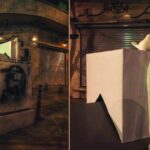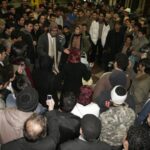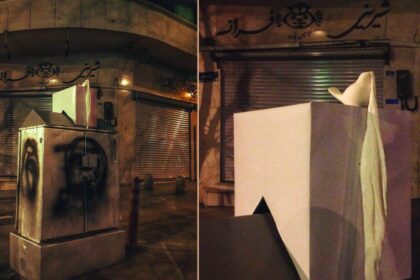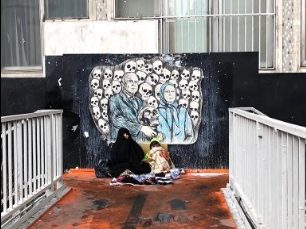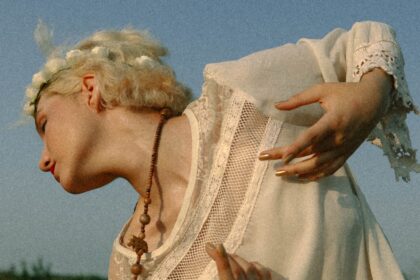On Top of the Mountain: Once Upon a Time there was a Monument
Behzad Khosravi Noori

At the intersection of Felestin (Palestine) Street and Talaghani Street in Tehran, in the middle of a large roundabout, there is an allegorical bronze-and-cement sculpture. Depicting several figures, one with a fist raised in a gesture of defiance, the work is a monument to the Palestinian struggle, and the First Intifada in particular, designed by Nader Qashghaie. The First Intifada was an ongoing succession of Palestinian demonstrations against the Israeli occupation of the West Bank and Gaza. It lasted from December 1987 until the Madrid Conference in 1991, and it was precisely during this period that construction of the monument took place, from 1989 until its inauguration in 1990. The sculpture was the first public monument ever built in postrevolutionary Tehran.
The point of departure for this article is a monument to the Palestinian struggle located at the center of Tehran. In this essay I will explore its historical background as well as its contemporary relevance. My analysis will go beyond the physical nature of the monument and its location to address the forms of fantasy, imaginary discourse and spatiality that frame and contextualize it, viewed through the lens of the contemporary history of art and politics. In fact, the Palestinian monument in Tehran is a site- and context-specific example that serves as a conceptual point of departure for a diverse array of analogous political contexts and historical entanglements.
This article presents the research process through the examination of archival materials unearthed in the course of a collaborative filmmaking project that juxtaposed commentary on this found footage with an analysis of the materiality of the monument and Felestin Square. By exploring the relationship between two hyper-politicized social environments—Palestine and Iran—I attempt to bring micro levels of historical narration into dialogue within the multiplicity of relationships between art and politics.
I approach these subjects from different historical perspectives, investigating the materiality of contemporary history and the multiple and complex range of interactions, connections, entanglements, and micro-histories embedded in our near past. Through the reenactment of material history, I ask how art and artistic research can excavate the image of contemporary history in the present and suggest a possible future for the images of contemporary history. I also ask what happened to these images after they crossed the border?
In the Dermis of History
“Why is the map upside down?” My Palestinian friend immediately asked after I showed him an image of the monument that appeared in a Google search. I hadn’t noticed the map was upside down. It was an agonizing moment, and I didn’t have an answer. I Googled “Palestine map.” The first image that appeared bore the title “The Palestinian Historical Compromise,” and comprised four maps arranged together: Historic Palestine, 100 percent; 1947, 44 percent; 1967, 22 percent; and present, 16 percent.[1] Immediately I felt the need to undertake an exploration, an archeology that would illuminate what I have taken for granted about Palestine. I wanted to dig ibeneath the “dermis” of history and develop a sondage of the stories buried beneath this upturned allegory—a deeper investigation of one part of a broad trench of history.
How could I talk about these stories? Was there a story hidden within the colonial past and present, one that had resisted the amnesia of time and endured? I had to ask again: How can I understand the monument in relation to the history of Palestine? It is a form of activism, but supported, founded, and built by another hegemonic order which appropriated the resistance of Palestinians in order to achieve its political gain in regard to the Iran-Israel proxy conflict.[2]. What role did the notion of activism and art play here in the center of Tehran? And what will happen to the story embedded in the monument when it crosses the border?
There are resemblances between the Palestinian condition and one I call “hyper-politics”: a permanent life within an organic crisis; a realm where any action or motion is immediately associated with one or the other side of a conflict that took place in the abyss of past millennia, or else will occur in the future (whether today, tomorrow, or decades from now). The hyper-politicized realm is occupied by a hoary, dying political and historical order, an apparatus in which history has become a quarry from which we cut stones to hurl in each other’s faces. There is no solidarity. Society has fragmented; otherization, the introduction of division and social separation, thus constitutes the primary “morbid symptom” of a hyper-politicized social environment.
That is to say, both Palestine and the hyper-political reflect colonization by the grand narrative of the epistemological pressure exerted by the ongoing flow of historical time. Nevertheless, layers of histories, from Palestine’s colonial past to the post-1947 occupation, make it a space defined by the eternal battle between colonizer and colonized, and between oppressor and oppressed [3]. The colonial progression has proceeded, millimeter by millimeter, to subjugate the immense expanse of land that lies between two rivers, [4] the promised land that I cannot access as stipulated by my Iranian passport: “The holder of this passport is not entitled to travel to occupied Palestine”. Indeed this constitutes the main obstacle to my thought. Where does memory begin? Perhaps it emerges not as a tool to access the past, but from the earth in which the past lies buried.
A Letter from an Exiled Kid from Palestine
In the mid-1980s, I was eight years old. One of my second-grade assignments was to write a letter to a Palestinian kid. The imaginary Palestinian kid in our school textbook had already sent us a fictional letter, in which he told us his story, and talked about the situation in Palestine—the suffering, pain, death, murder, and inhumanity of their condition.
He wrote:
Do you know me? I am your brother. I am Palestinian. We Palestinian kids are Muslim. The name of our country is Palestine. You in your own country live in your home, but we live homeless in the deserts in exile, because the enemy occupies our home and our country.
We spend day and night under the tents, where we study, too. The enemy kills us and burns our tents. I must say that since your revolution began, the enemy is more fearful, and because of that they torture us more.
To practice writing a letter, we had to send our replies. It was perhaps the first letter that I ever wrote. I don’t remember the content; perhaps I repeated whatever our teacher told us to write. In the process, we learned new words and phrases, such as:
Occupy (اشغال): to take by force
Return (بازگشت): to come back
Adrift (آواره): to be without a home, to be forced out of one’s country
Exile (تبعید): to displace, to banish
Protest (اعتراض): to disagree, to oppose something
Tabernacle (چادر): tent
Executioner (شکنجه گر): killer, murderer, torturer
Break the silence (شکستن سکوت): to begin to talk
And there were more new terms, such as struggle, combat, and explosion.
The illustration that accompanied the letter was a drawing of a Palestinian kid, gazing out with his big eyes—very large eyes, I must say—wearing the Palestinian keffiyeh. In the background were a couple of tents in a phantasmal desert. The illustration served as the basis for my impression of Palestine for a long time. Representations of distance and barriers seemed to play a defining role in our understanding of Palestine and Palestinians. Indeed, in 1980s Iran they were a vehicle for the production of a collective imaginary of Palestine and the Palestinians; they were a means for the continuation of notions of occupier and resister, and for the association between war and anger, and between emancipation and occupation.
When did the imagery of exodus and resistance become representative of Palestine in Iran? And what happened to these images after they crossed the border from Palestine to Iran? The adoption of a particular stance on the pain of the other eventually became part of Iran’s political agenda, used to clarify its foreign political doctrine and, perhaps even more importantly, as a domestic tool to differentiate between friend and foe. A token and useful other-in-pain who could justify the Islamic republic’s claim of being a supporter of the proletarians of the world.
An Unknown Plane
Early in the morning of Monday, February 18, 1979—a week after the Iranian military’s declaration of neutrality and the announcement of the victory of the Iranian revolution—the control tower staff at Mehrabad International Airport received a landing request from an unknown foreign plane. Due to the uncertain political environment, Iran’s airports had become accustomed to such irregularities over the preceding two months.
The plane carried Palestinian Liberation Organization leader Yasser Arafat, together with fifty-eight other PLO officials. The irony of Arafat’s visit was evident: Arafat was treated as a hero in the same land that had supplied much of Israel’s oil; the country where Israelis had participated in training the SAVAK, the shah’s secret police; and where both Israeli and Iranian pilots had trained on U.S.-supplied F-4 Phantom fighters.[5] Now this alliance had been overturned by Iranian opposition to the shah and also the Palestinian’s shared common historical ground: anti-occupation and anti-Zionism. Some of the Iranian revolutionaries had trained in PLO camps in southern Lebanon, where they had merged with the Lebanese Shia villagers and their militias.[6]
During his visit, Arafat announced that Ayatollah Khomeini [7] had assured him Iran’s revolution would remain unfinished until the Palestinians achieved their goal. The PLO had established a mission in the former Israeli embassy in Tehran, as well as in Ahwaz and Khorramshahr, in the center of the Iranian oil province. The PLO representative in Tehran was Hani al-Hassan of Fatah, its conservative Muslim wing. By selecting a more Muslim-oriented representative, Arafat sought to send a clear message of adherence to Khomeini’s ideas about the Islamic identity of Palestinian resistance.[8] At an official ceremony attended by both the prime minister of the interim government of Iran, Mehdi Bazargan, and the short-term foreign minister, Karim Sanjabi, the keys to the Israeli embassy were ceded to the PLO leader. It was then that Felestin Street, on which the embassy is located, along with nearby Felestin Square, received their names [Felestin is Farsi for Palestine]. Some members of Arafat’s entourage eventually stayed in Iran, managing the PLO offices in several cities.[9]
The divergence between the PLO and the Iranians began immediately after Arafat’s arrival and his two-hour meeting with Khomeini. Khomeini leveled deep-seated criticisms of Arafat and the PLO. The Palestinians were shocked to encounter the angry imam, rather than a welcoming spiritual leader. Khomeini lectured Arafat on his obligation to get to the Islamic root of the Palestinian issue, and warned against his leftist and nationalist tendencies.[10] In addition, the Iranian leader argued that an Islamic orientation of Palestinian resistance would increase their chances of victory, as well as preclude a takeover by Marxist and communist tendencies among their ranks.[11]

However, the generally leftist oriented ideology—mainly Marxist-Leninist—played a significant role both preceding and during the Iranian revolution. However, an [Islamic and] anti-leftist rhetoric would eventually become dominant within post-revolutionary Iran. Although, when it came to Palestine, leftist political rhetoric constituted an Iranian attempt to take over leadership of the Palestinian struggle. Ultimately, Iran’s efforts to influence the direction of Palestinian resistance, whether on the basis of Arab nationalist identity or in its opposition to socialism, would not play a major role in Palestine. The identity crisis that was unfolding between the Iranians and Palestinians was not just at the meta-level of political ideology: as one Iranian who hosted the Palestinians complained, none of the Palestinians were religious. Most of them drank alcohol, and they wanted to watch films.[12] “Were these really the Palestinians?” the Iranian Revolutionaries asked themselves. The imaginary Palestine that the Iranians had created in their minds didn’t resemble the reality of actual Palestinians. Such ideological dissimilarities between the Iranian revolutionaries and the PLO representatives led to an atmosphere of ambiguity that would prove damaging for future attempts at collaboration.
When tensions emerged between Tehran and the Gulf Cooperation Council (GCC) states, soon after the revolution, Iran began to publicly accuse the PLO of exacerbating the impasse between the Arabs and the Persians in Ahvaz, a city largely populated by Arabic speakers.[13] Only a few months after the inauguration of the PLO’s Ahvaz office, it was shut down; meanwhile the PLO embassy in Tehran was placed under close surveillance. In order to compensate for his actions against the Palestinians and appeal to the broader Arab and Muslim masses, Khomeini turned to rhetorical means to cover up Iran’s actual policies. It was then that he declared the last Friday of Ramadan each year to be Quds Day, exhorting Muslims worldwide to demonstrate on that day in support of the Palestinians.[14] However, the Quds Day celebrations demonstrated only that Iran’s disinclination to deliver concrete assistance to the Palestinians functioned more as an ideological position than as an expression of practical support.[15] Khomeini’s strategy may have been an aesthetic one, too. Then, in 1980, the war between Iran and Iraq broke out. Arafat sided with Saddam. The former Palestinian hero thus became a tabloid caricature. Hyperbolic depictions of Arafat’s secular, Marxist, Arab-nationalist identity became a permanent feature of the Iranian revolutionary narrative.
A Postmodern Bricolage
Before the 1979 revolution the square’s center had been occupied by a fountain, surrounded by statues of putti and swans. Today, its focal point is the monument to Palestine and its central feature is the map that is upside down. During the 1990s, the square became a location for anti-Israeli demonstrations, which took place on the last Friday of Ramadan (known as Quds Day). But this location is not defined solely by its political connotations: there is also an art school near the intersection between Felestin Street and Enghelab (Revolution) Street, along with several small optometrist shops on both sides of the street, indicating the square’s everyday identity. On one side of the bronze-and-cement monument a mother protects her child, in a reinterpretation of the Pietà by Michelangelo. On the other, there are two masked men; one marches, right fist in the air and a book in his left hand; the second impersonates an Intifada stone thrower. In the middle of the monument there is a hollowed-out silhouette of the Dome of the Rock. Social realism and neoclassicism fuse in this bricolage. How did this amalgamation of themes take shape in the sculpture?
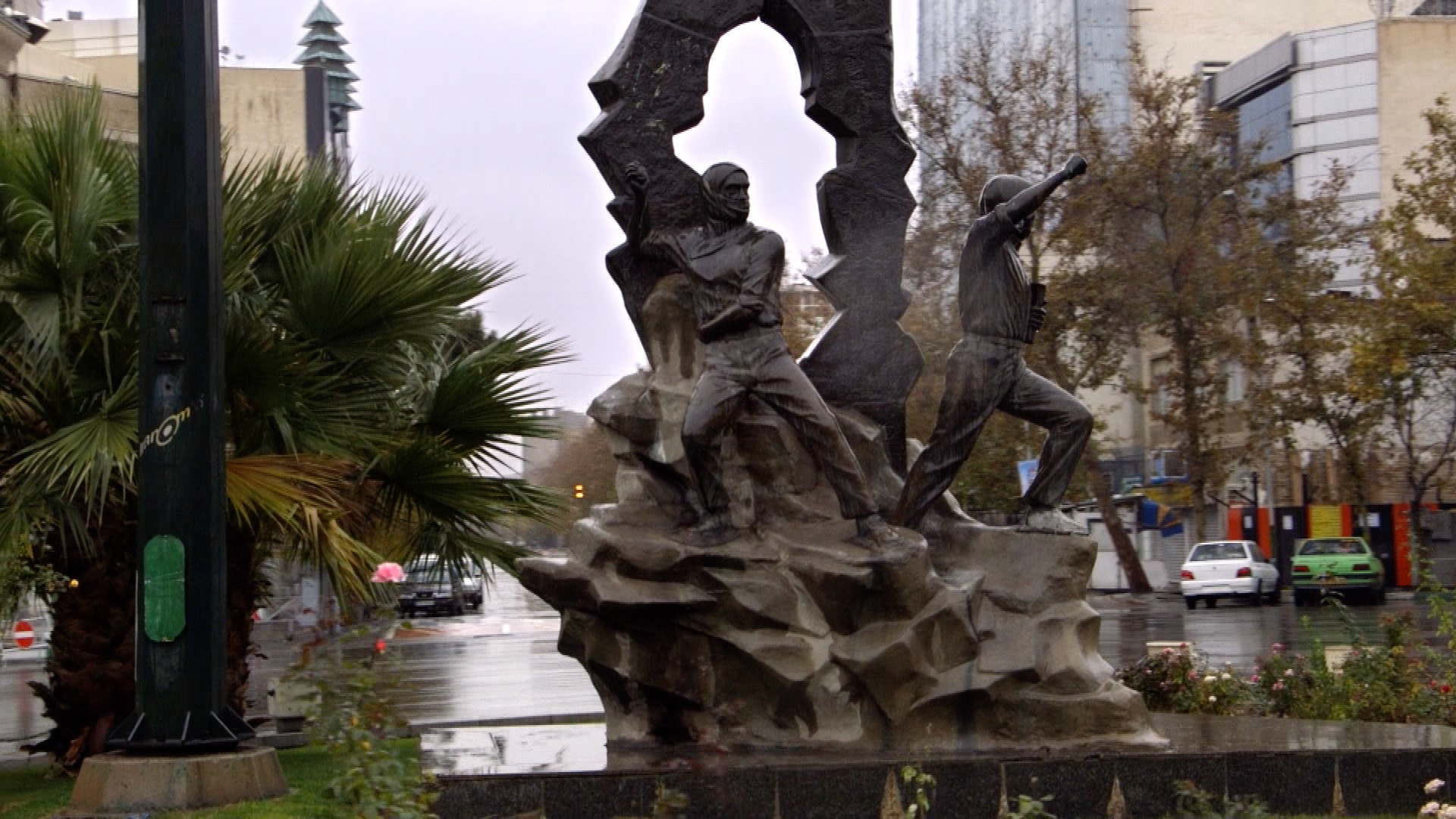
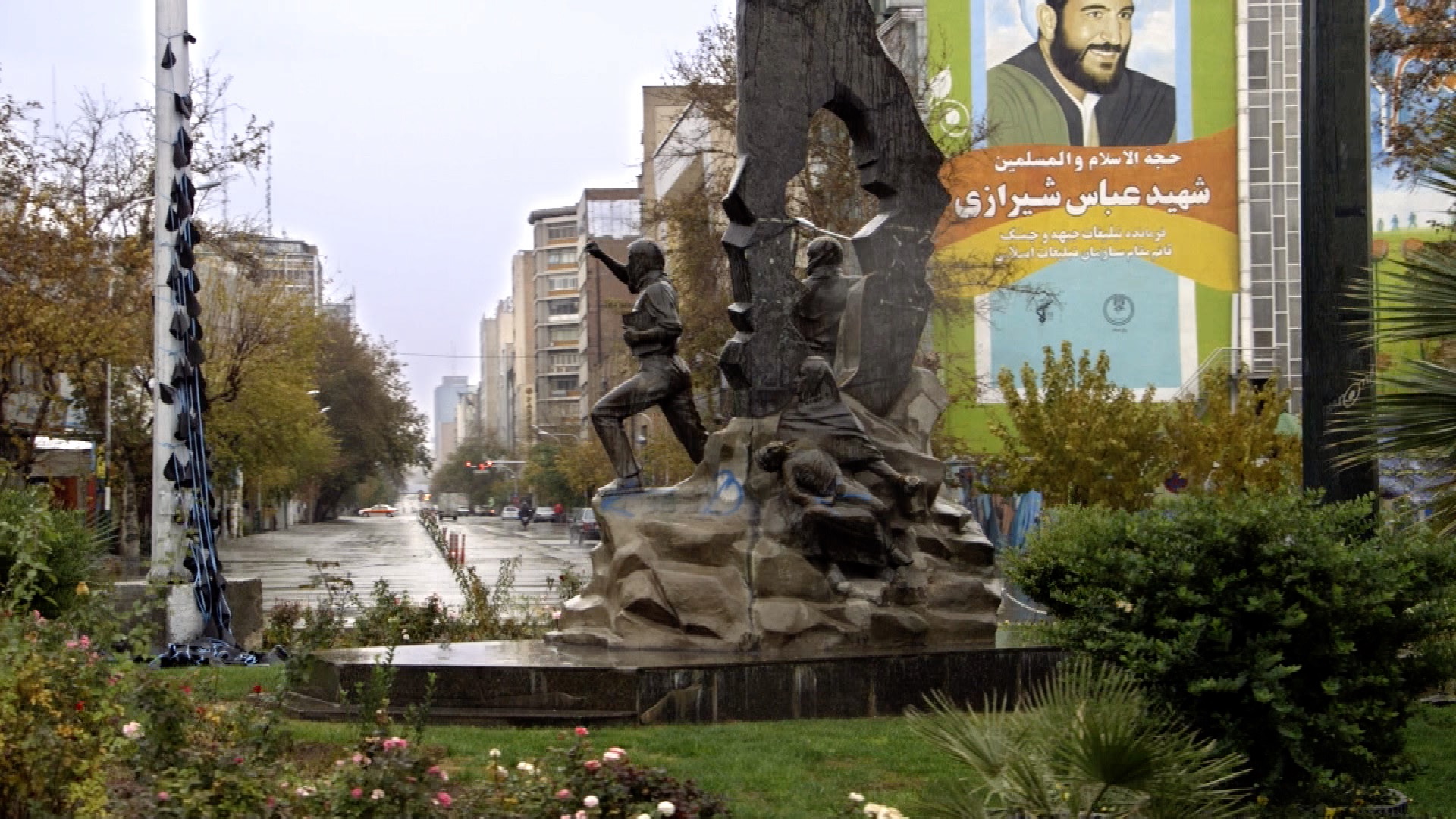
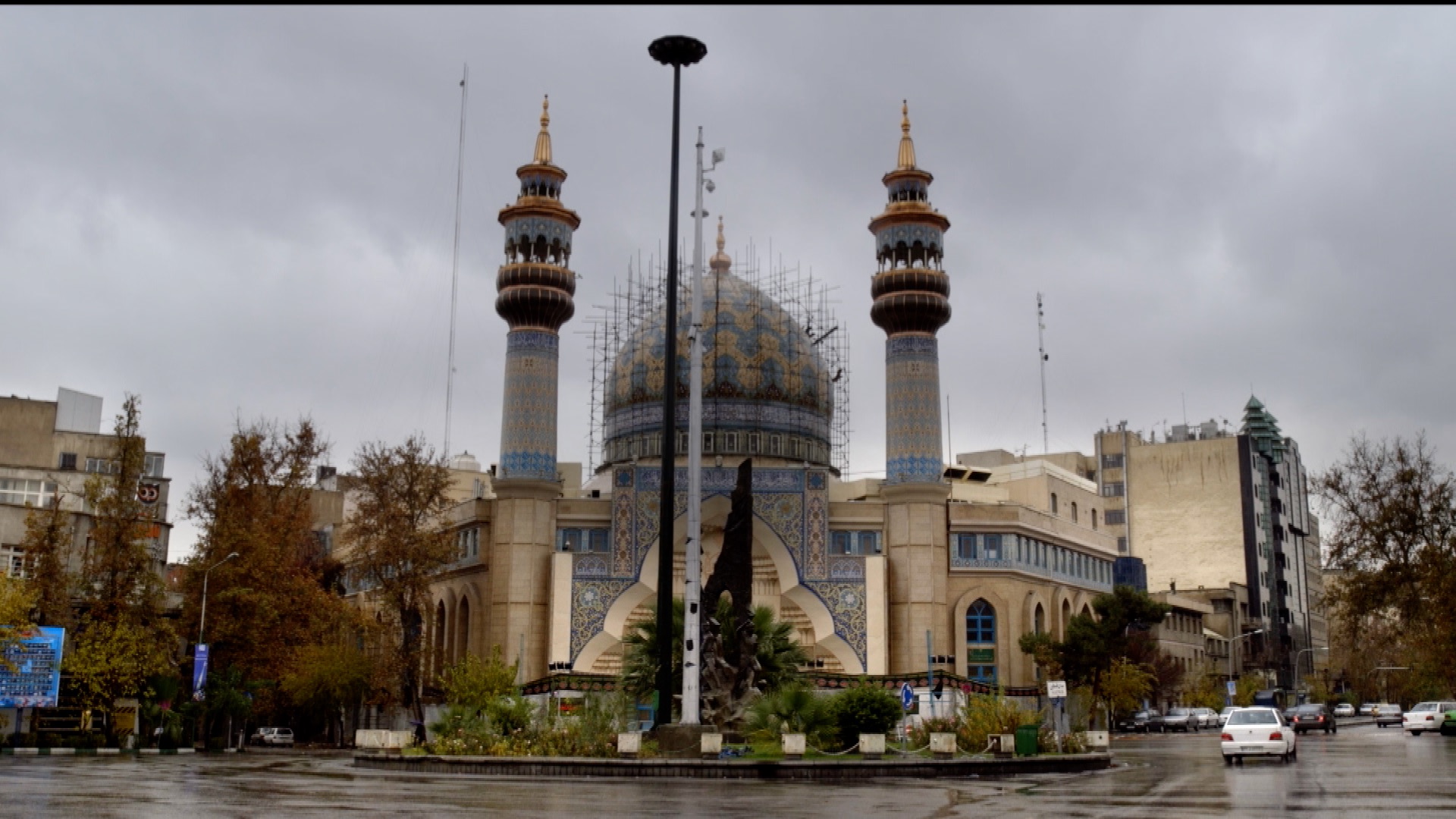
The Trembling Hand of Social Realism
On November 6, 1979, just two days after the occupation of the U.S. embassy in Tehran, Amirzargham Adham, an art student from the University of Tehran and a Muslim revolutionary, approached his Assyrian Christian Marxist teacher to propose an idea for a mural on the wall of newly occupied U.S. embassy. His teacher, Hannibal Alkhas, was affiliated with the Tudeh Party.[16] As Alkhas later described their conversation,[17] it centered on the essence of art—the notion that painting is a form of labor, and a reflection of events that serves as a means to communicate with people. He expressed a strong desire: “if only they would let the students paint a mural on the wall of the embassy!” [18] Adham took the proposal seriously and sent a letter to the embassy’s administrators. Just four days later, they received permission to narrate The Iranian revolution on the wall of the embassy on Talaghani Street. The fifty-square-meter wall thus became the first revolutionary street art in Tehran.
Immediately after the first wall painting, Alkhas’s other students began to scour the city for more walls they might adorn, according to their revolutionary desire. Nilofaur Ghaderi Nejad, one of his young and ambitious students, described the environment: “We learned and talked a lot about social realism, Mexican revolutionary painters such as Diego Rivera, David Alfaro Siqueiros and José Clemente Orozco paintings in Alkhas Atelier. We were very excited and looking for an opportunity to do similar things on the walls of the city of Tehran.”[19] Tehran had become an open canvas for Marxist art students to practice and explore what they had learned from their teacher.
When Socialism Comes from the West
Alkhas left Iran for the United States in the mid 1950s, hoping to become a medical doctor—however, he immediately changed his mind, deciding on philosophy, and then, not long after that, settling on art and painting. He studied at the Art Institute of Chicago under the supervision of Boris Anisfeld, a Jewish Russian-American symbolist painter and theater designer, and a close friend of Maxim Gorky.[20] Perhaps the development of Alkhas and Anisfeld’s close relationship was due to their shared views on the multiplicity and complexity of their social position, something each expressed through the eclectic use of religious motifs and symbolism; in Anisfeld’s work, this tendency was surely a reflection of his need to at once assume several identities, including as Russian, Jewish, and an artist. For his part, Alkhas’s work reflected his positionality as an Assyrian, a Christian, an Iranian, and later as a Marxist artist.
It was around this time that Alkhas became increasingly mesmerized by Marc Chaghall’s painting and the work of the Mexican revolutionary muralists, along with prehistoric Assyrian motifs from ancient Mesopotamia. After returning to Iran in 1963 and joining the Tudeh Party, he sought to introduce muralism to urban postrevolutionary Tehran after the 1978 revolution. Because he believed galleries were ill-suited for proletarian art, he saw it as essential that he would bring art to the public in the streets.[21] Alkhas soon became an influential professor at the University of Tehran, particularly among revolutionary students, whose views represented a wide range of Marxist and Islamic ideologies. Although his Muslim students engaged with his socialist approach toward art and painting, they eventually tried to claim an autonomous position as Muslim revolutionary artists. The distinction was apparent by the time his students painted the mural on the wall of U.S. embassy, after which Alkhas was accused by other members of the Iranian political opposition of supporting Islamists. He elucidated his political position by pointing out the specific features he painted: “I simply painted the first stage of the revolution, which was about proletarians and farmers, independence and anti-imperialism. And Adham painted Khomeini.” He continued, “I won’t be ashamed of my actions in the future.”[22] Alkhas’s activities as a teacher and artist played a significant role in the introduction of socialist art to the scene in Tehran. He had a permanent tremor in this hands, which meant that he couldn’t hold a brush properly, and which affected the realism of his work. Were all the exaggerated features, the free-form lines and the deformed bodies in his work in fact the result of his tremor? Could he have become a renowned social realist painter if he hadn’t developed this condition? In any case, the fact remains that socialist painting was introduced to Iran by an artist with an unsteady hand.[23]
The struggle between the Islamist and Marxist ideologies soon led to the onset of the Cultural Revolution in Iran. Attacks began against foreign influences on university campuses. On April 18, 1980, following Friday prayers, Khomeini gave a speech harshly condemning the universities. “We are not afraid of economic sanctions or military intervention,” he declared. “What we are afraid of is Western universities and the training of our youth in the interests of West or East.” The universities were shut down, and would not reopen for three years, one of the deepest historical legacies of the Cultural Revolution. Leftist ideology was, once again, stigmatized, and was frequently viewed as a vestige of the political realities that had preceded the revolution. Before long came the arrests of members of left political parties, including Ehsan Tabari, the head of the Tudeh Party who had been involved in the establishment of the first government after the revolution, and Saeid Soltanpour, the director of the Iranian Writers’ Association. Following show trials, both were executed.[24] The first revolutionary mural on the wall of the U.S. embassy—a visual collaboration between a Marxist and an Islamist—was soon concealed by a coat of white paint.
Morteza Goudarzi Dibaj, in his book Art and Revolution, argues that the reason very little monumental sculpture was produced in the first decade after the revolution had to do with the economics of producing sculpture, as compared to painting. An additional, and possibly more crucial, reason was uncertainty about the official Islamist stance on statues, and the ambiguity of the supreme leader’s position on the medium. However, when the University of Tehran reopened after the Cultural Revolution ended in 1983, it actively anticipated the emergence of the medium with the creation of a new department of sculpture.[25]
أن تكون ملكيا أكثر من الملك
More of a royalist than the king
On Wednesday, March 31, 1990, at 11 A.M., the inauguration ceremony began for the nine-meter-tall Palestine monument, organized by the Islamic Revolutionary Guard and the local branch of the municipal government. Ata’ollah Mohajerani, a senior member of President Hashemi Rafsanjani’s cabinet, gave an opening speech to an ambassador from the Palestinian embassy, a representative of Hezbollah from Lebanon, and representatives of the Palestinian movements Fatah and Hamas. He detailed the two years of planning and competition that had resulted in the bronze-and-cement sculpture. Mohajerani emphasized that the monument was a representation of the close relationship between Iran’s Islamic revolution and the ongoing revolutionary struggles of the Palestinian peoples which, in fact, was both a continuation of and strongly influenced by the Iranian revolution. To back up his argument in regard to the international impact of the Islamic revolution, he cited former Fatah activist Mounir Chafiq, as well as the Irish political scientist Fred Halliday.[26] He concluded his speech by proposing an idea for a new monument—one that would emphasize the Islamic basis for solidarity between Iran and Palestine—located in front of the presidential building, at the south end of Felestin Street. It was an idea that would never be realized.[27]
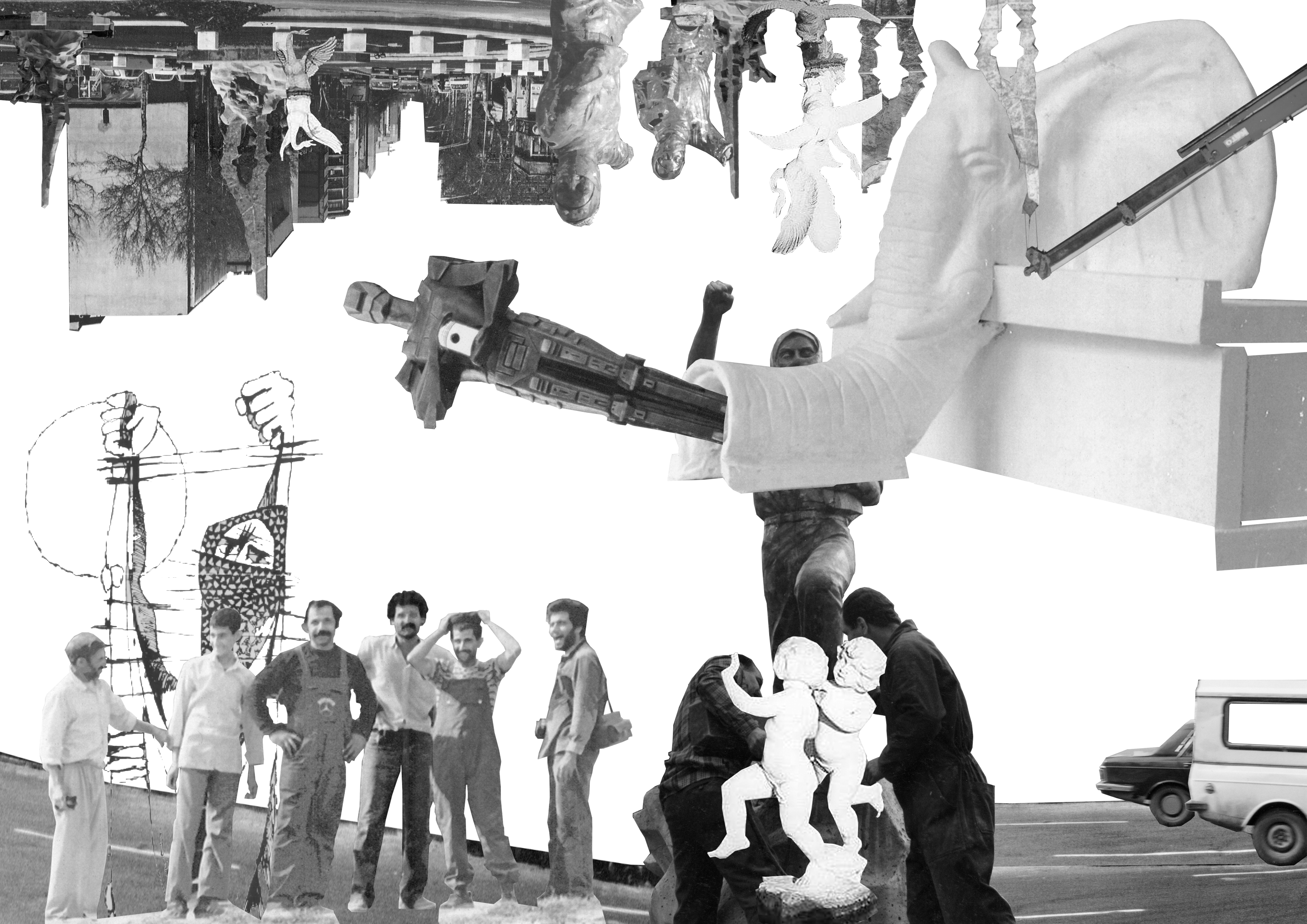
At the end of the ceremony, two of the guest speakers—a representative of the Palestinian embassy in Tehran named Mohammad Mostafa Jahir, and PLO ambassador Salah Zawvavi—expressed the hope that in the very near future all Muslims in the words could pray together at the al-Aqsa Mosque. The PLO delegates were actively engaged and involved in the design of the monument by suggesting the addition of another element, a Palestinian mother.
A Fat, Lazy Cat
In the summer of 2014, I published what may have been my most bitter essay yet. The one-page text was published in Tandis, a biweekly art magazine in Tehran, as part of a visual companion to the opening of an exhibition about Gaza and the Palestine occupation, which was sponsored by the Ministry of Culture and curated according to official Islamic guidance. The exhibition took place in the midst of Israel’s renewed siege of Gaza and the West Bank. The devastating news and horrific images repeatedly detailed the timeline of the Israeli military operation and the mercilessness of its incursion into the occupied territories.
Such bombastic political rhetoric against Israel became even more visible in Iran during the siege of Gaza Strip. During that time, a group of contemporary artists decided to have an exhibition at the Niavaran Historical Cultural Complex, located in northern Tehran, near Pahlavi Castle (the former residence of Mohammad Reza Pahlavi the Shah of Iran). The complex is known for its distinctive architecture, which was designed by Queen Farah Diba’s cousin, Kamran Diba. The exhibition included visualizations of violence, romantic observations about the devastated Palestinian landscape, and poetic criticism, accompanied by soft background music and the scent of perfume and cologne—questionable features that were only compounded by the social and political implications of the bourgeois location. Perhaps it was the combination of these elements that so aggravated me, the audacity to define this as “politically engaged art” while surfing on a river of blood. The artists’ engagement with their practice was like that of a fat, lazy cat living in a bourgeois house: they were simply waiting for an opportunity to catch your eye and get petted. It seemed that the bloodbath in Palestine was an opportunity for them to pantomime political engagement—or even activism—from a privileged place of safety and comfort. And even more importantly, their artworks realigned them with the official stances of the Iranian government and Ministry of Culture, including formal Islamic Guidance, following eight years of ongoing govermental interference in cultural production during the Ahmadinejad government.
I left the essay unfinished, perhaps unintentionally. Among those who agreed with the premise, the most common criticism I received concerned its failure to recommend a path forward: “Sure, but what should we do?” Indeed, how can one adopt a critical stance toward the Palestinian occupation without feeding into yet another state of propaganda? I didn’t have an answer to this question then, and perhaps I still don’t. How is it possible to talk about a territory where I cannot travel? What is the language of critique when critical language has become a commodity—a salable object of desire that follows the capitalist logic of reproduction. Even though most of the artists who participated in the exhibition had an established connection to various commercial galleries, participating in this exhibition could still provide them with safe cultural capital, secure in Iran, and safe in the realm of global contemporary art beyond the geographies of east and south.
Is critical language still critical if there is a market for it? And how much does it cost? What can I know about Palestine when I cannot travel to occupied Palestine? What happens to the image of Palestinian suffering when it crosses the border and is exhibited in another context? The fact that the article I wrote remains unfinished somehow suggests the impossibility of the situation. Palestine becomes a “phantasmagoria,” in a sense similar to that employed by Walter Benjamin in his Arcades Project.[28] It is a phantasmagoria of resistance—an object that is seen not in terms of its functional or financial value, but for its lyrical assessment and construction of a form of romanticism, or romantivism: romantic-activism. It is in the context of such a sentimental value system that imagination comes into play, that is, in the fiction of a place where one has never been. It is a phantasmal geography of the other, the narrative that makes this sculpture a monument. In some way, phantasmagoria is not a micro concept here, but a primary state of mind: it is a grand concept that defines what things should look like, a fetish. Iran’s political role in relation to Palestine has become akin to that of a backseat driver, shouting unwanted advice or arguing about their actions.
Benjamin once said history breaks down into images, not stories.[29] But the orthodox understanding of the past—Benjamin calls it historicism—doesn’t find its basis in the material evidence of the past. Rather, the explicit object of this new approach to history is not the missing past, but the present. What institutes the materiality of the present is, undeniably, nothing other than the bricolage of all the aspects of the past that are conserved in the present. Thus, what he proposes constitutes an archaeology of the present. Iran and Palestine are two distinct geographies, and though they have shared histories, they remain distant from one another. Their only relationship is through representation and images, but these images alone are not enough to undo the violence of history. Is there a way to bring the art of storytelling back into such a hyper-politicized history? The image of our collective past demands reinvention in order to confirm the possibility of thinking about social transformation, emancipation, and solidarity from a new perspective: an alternative way of thinking that entails an alternative method of investigation.
Behzad Khosravi Noori was born in Tehran in 1976. He currently resides in Stockholm and in Tehran. His research practice involves films, installations, and archival research. He explores the history of the Global South, of labor and the means of production, and the history of political relations that existed as a counterargument to the East-West dichotomy during the Cold War. Behzad analyzes modern history with the aim of returning to memories beyond the mind. Behzad Khosravi Noori uses his own experience as a springboard to establish, through artistic research, a hypothetical relationship between personal memories and significant world events, between micro- and macro-histories. In his works the special attention is paid to films and historical materials in order to ask questions such as: what will happen to the narrative when it crosses the border? What is the future of our collective past?
Notes
[1] The conversation took place in 2015. However the notion of ”present” here emphasizes the time period between 2015 to 2021 while I was working on the project.
[2] The Iran–Israel proxy conflict is an ongoing conflict between Iran and Israel. The conflict is bound in threats, the hostility of Iran’s leaders against Israel, and their declared objective to dissolve the Jewish state. Israel is concerned by Iran’s nuclear weapons program, and is seeking to downgrade Iran’s allies and proxies such as the Lebanese Hezbollah political-militant organization. The conflict gradually emerged from Iran’s hostile stance toward Israel following the 1979 Iranian Revolution, into covert Iranian support of Hezbollah during the South Lebanon conflict (1985–2000) and by 2005 developed into a proxy regional conflict.
[3] Here I refer to mandatory Palestine, which was a geopolitical entity established between 1920 and 1948 by Britain in the region of Palestine under the terms of the League of Nations Mandate for Palestine.
[4] On the basis of the description of the borders of the promised land given in the Book of Genesis, Arafat had claimed that the two blue stripes on the Israeli flag represent the Nile and Euphrates Rivers, and alleged that Israel desired to eventually seize all the land in between. See, for instance, Daniel Pipes, “Imperial Israel: The Nile-to-Euphrates Calumny,” Middle East Quarterly (March 1994), https://www.meforum.org/215/imperial-israel-the-nile-to-euphrates-calumny
[5] John K. Cooley, “Iran, the Palestinians, and the Gulf,” Foreign Affairs vol. 57, no. 5 (Summer 1979), p. 1017.
[6] In the mid 1970s some members from People’s Mujahedin of Iran (MEK) trained at Palestinian Liberation Organization camps in Jordan and Lebanon. See “The Mujahedin-e Khalq in Iraq a Policy Conundrum,” Jeremiah Goulka, Lydia Hansell, Elizabeth Wilke, Judith Larson, (Santa Monica, CA: Rand Corporation), 2009, p. 56.
[7] Sayyid Ruhollah Musavi Khomeini (May 17, 1900–June 3, 1989), also known as Ayatollah Khomeini, was an Iranian political and religious leader. He was the founder of the Islamic Republic of Iran and the leader of the 1979 Iranian Revolution.
[8] Cooley, “Iran, the Palestinians, and the Gulf,” p. 1017.
[9] Trita Parsi, Treacherous Alliance: The Secret Dealings of Israel, Iran and the United States (New Haven and London: Yale University Press, 2007, p.85.
[10] Ibid.
[11] Confidential State Department telegram from the U.S. embassy in Iran, October 1979, sent by Chargé d’Affaires Bruce Laingen. Available at the National Security Archive, https://nsarchive.gwu.edu/.
[12] Parsi, Treacherous Alliance, p. 86.
[13] Ibid.
[14] Nader Entessar, “Israel and Iran’s National Security,” Journal of South Asian and Middle, Eastern Studies 4 (2004), p. 6.
[15] Parsi, Treacherous Alliance, p. 88.
[16] The Tudeh Party of Iran (‘Party of the Masses of Iran’) is an Iranian communist party. It was established in 1941 with close affiliation with the Soviet Union. It had substantial influence in its early years and played an important role during Mohammad Mosaddegh’s campaign to nationalize the Anglo-Persian Oil Company during his term as prime minister. Tudeh identified itself as the historical outgrowth of the Communist Party of Persia.
[17] First Book of Iranian Writers’ Association (Tehran: Autom, 1979).
[18] Ibid.
[19] Niloufar Ghaderinejad, interviewed by Ilna, Reza Yasini, Iranian Labor News Agency, May, 22, 2018, www.ilna.news.
[20] Eckart Lingenauber, “Boris Anisfeld: A Wanderer between Russia’s Silver Age and America’s Golden Twenties,” available at www.anisfeld.org.
[21] Nameh Mardom, 5 Mehr 1389, Issue 852, year 25th. my translation. Available at: www.tudehpartyiran.org.
[22] Ibid.
[23] The Moscow-based publishing house Progress played a significant role by distributing inexpensive books in Farsi in front of the Soviet embassy, which helped familiarize many people with Marxist-Leninist philosophy, as well as art history, and even children stories. Progress became a well-known publisher before the revolution; remarkably it was not banned by the Secret Police (SAVAK)
[24] It is crucial to mention that the left-wing political party in Iran, as in any other geopolitical context, was not a homogeneous group. The history of the Iranian left is a complicated one, on account of the numerous splits and internal conflicts. Among them, the Tudeh Party, especially after the movement for oil independence, became the major political party in Iran, and somehow the representative of Marxist-Leninist ideology.
[25] Although in ideological terms they were quite different, both groups represented middle-class constituencies, and the foundations of their education and their political aspirations were similar in their disconnection from proletarian identity in Iran.
[26] Interestingly, while Fred Halliday was an Irish scholar, Mohajerani represented him as British.
[27] Municipal publication of the city of Tehran, no. 11 (Spring 1990), pp. 10–11.
[28] Walter Benjamin, The Arcades Project, (Cambridge, MA: Harvard University Press, 1999), p. 7.
[29] Ibid., p. 476.


